Author:
Reported by Cliff Keys, Editor-in-Chief, Power Systems Design
Date
09/18/2010
I had the opportunity to visit Fairchild's offices in Germany and to talk with Jonathan Harper, Market Development Manager, who is responsible for the technical marketing of industrial products for power electronics applications. He took me through the broad industry requirements and the corresponding technology and products in Fairchild's portfolio.
The Need for Energy Efficiency for Low and High Power Levels can be looked at as two areas: Low power - the need for primary side regulation (PSR) Chargers are becoming smaller and smaller, legislation is pushing for higher levels of efficiency and there is the need for low cost SMPS solutions. PSR eliminates the entire secondary side feedback circuitry such as optocouplers reducing dramatically the Bill of Materials (BOM) and cost. Additionally, the lower component count reduces footprint and increases reliability due to the reduction in interconnections. High power - the need for Power Factor Correction (PFC) Power factor (PF), one measure of power quality indicating how efficiently energy is drawn from the AC source is becoming a vitally important aspect of power design. Legislation in Europe, Japan and USA for energy conservation has lead to manufacturers having to adopt active PFC in their product designs.
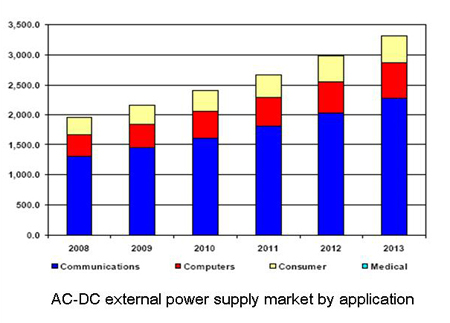
The largest growth segment for AC-DC external power supplies (<75W) is in communications and is largely driven by the mobile phone market and expected to grow to 2.3 billion units in 2013. This represents a large total amount of power.
Fairchild Semiconductor's industry-leading portfolio of primary side regulation (PSR) PWM controllers offers designers of mobile chargers, adapters and LED lighting applications multiple solutions to meet the stringent power and regulatory specifications such as ENERGY STAR® Level V. In charger and adapter applications, designers have been challenged to lower standby power and achieve higher efficiency, all while reducing the form factor of their designs. Currently in these applications, RCC or other IC solutions are used with varying degrees of success.
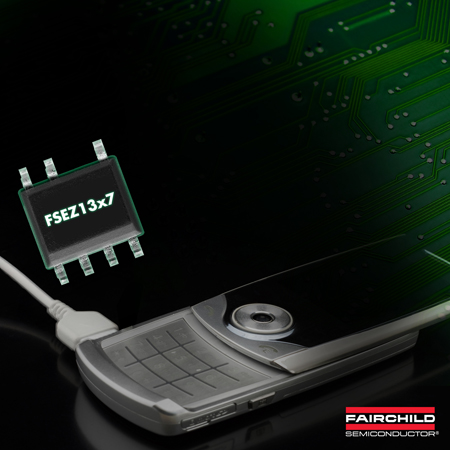
With the broadest portfolio of PSR PWM controllers in the industry, including the FSEZ1307 PSR controller with high voltage (HV) start-up and an integrated MOSFET, Fairchild devices simplify designs, save board space and meet today's demands for power savings. Key features available in the Fairchild portfolio are 30mW standby power, HV start up and an integrated power MOSFET for ease of design, primary side regulation without secondary side feedback and a universal AC input range. Unlike competitive solutions, Fairchild's PSR PWM controllers achieve constant voltage (CV) (Ī5%), constant current (CC) (Ī7%), 30mW standby power and ENERGY STAR Level V efficiency, all with a competitive bill of materials (BOM) cost and component count. For LED lighting applications, Fairchild's PSR PWM controllers achieve the most accurate CC through built-in, proprietary TRUECURRENT™ technology and tight CV without secondary-side feedback circuitry. Constant current allows the device to accommodate different numbers of LED units in a string, increasing design flexibility, stretching the lifetime of HB LEDs and reducing time-to-market. Fairchild's PSR PWM controller portfolio, including the FSEZ1307, FSEZ1317 and FAN103, enhance Fairchild's extensive power offerings that enable efficient electronics and maximize energy savings in power-sensitive applications such as power adapters, power supplies, lighting applications, computers, industrial controls and home appliances.
To meet ENERGY STAR® regulations and reduce their carbon footprint, power-electronic design teams continue to push efficiency towards the 100 percent rating, bringing higher system efficiency to PCs, servers, industrial power supplies and consumer electronics. Active PFC must be deployed to achieve these efficiency levels.
To meet ENERGY STAR® regulations and reduce their carbon footprint, power-electronic design teams continue to push efficiency towards the 100 percent rating, bringing higher system efficiency to PCs, servers, industrial power supplies and consumer electronics. Active PFC must be deployed to achieve these efficiency levels.
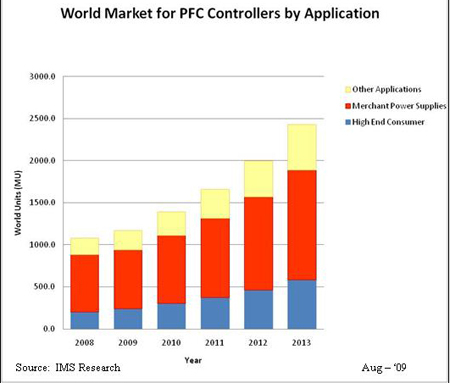
The market for PFC controllers is driven by three main applications: High End Consumer
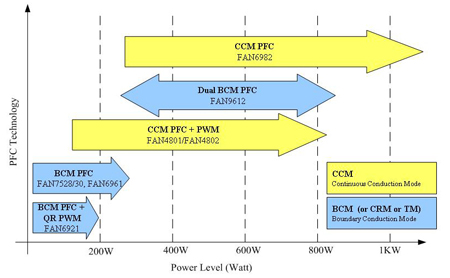
Fairchild has leveraged its expertise in power to develop a CCM PFC controller for 300W to 2kW power supply designs that bring high system efficiency, high power factor and low THD. Through its high level of integration, this CCM PFC controller eliminates 54 external components.
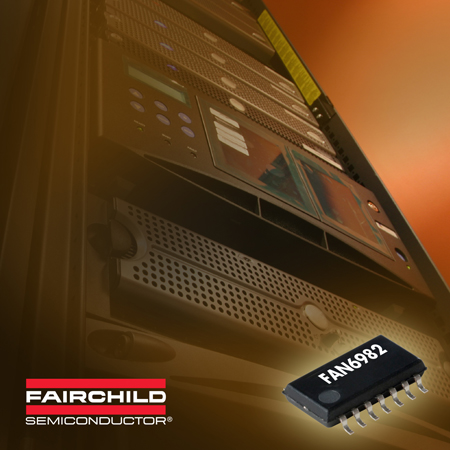
Power Factor is an important measure of power quality and shows how efficiently energy is drawn from an AC source. With all PFC controllers striving to reach the ideal power factor of 1, Fairchild's CCM PFC controller, the FAN6982, reaches near unity with 0.999 of PF at full load.
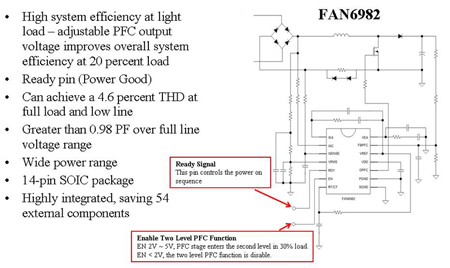
This means that utility companies do not have to supply as much power to electronic applications. With power factor controllers like Fairchild's FAN6982, AC harmonic currents resulting from today's complex loads can be virtually eliminated, thereby allowing for a much more efficient power distribution system. Fairchild's FAN6982 maintains high system efficiency at light load conditions to meet 20% load system efficiency requirements of ENERGY STAR® regulations and Climate Savers Computing Initiatives. It achieves this by reducing capacitive switching losses and by reducing the voltage conversion ratio, which results in less conduction losses in the boost switch. This CCM PFC controller reduces external components and offers ease of design through its high level of integration. Features of the CCM PFC controller are: built-in brown-out protection, eliminating 12 components; adjustable PFC output, eliminating 17 components; RDY pin for power-on-sequence, eliminating 15 components; 30V operating voltage capability, eliminating 10 components; and PFC soft-start, eliminating 4 components - in total decreasing bill of materials (BOM) by 54 devices. Since many AC-sourced electronic applications have a microphone, amplifier or loudspeaker, which need an accurate reproduction of sound, this controller offers exceptionally low Total Harmonic Distortion (4.6 percent at full load) which reduces these harmonics and meets class D requirements of IEC 1000-3-2. The FAN6982 does this through its switching-charge technology that senses input current and voltage directly, helping to improve PF and THD. Fairchild Semiconductor provides the industry's most comprehensive portfolio of products for AC-DC power supplies. From CCM PFC controllers to BCM PFC controllers, these solutions help electronics to achieve higher levels of efficiency, lower standby power and ease of design. www.fairchildsemi.com